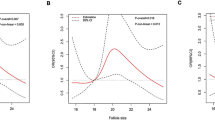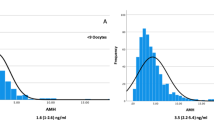Abstract
Purpose: Our purpose was to test whether age-related changes in antral follicle counts can predict the pregnancy outcome in the early follicular phase of a controlled ovarian hyperstimulation/intrauterine insemination (COH/IUI) program.
Methods: A selected group of 107 women (36 healthy women requesting child sex preselection, 52 women with unexplained infertility, and 19 with minimal endometriosis) who underwent controlled ovarian hyperstimulation with clomiphene citrate (CC) plus human menopausal gonadotrophin (hMG) and subsequent intrauterine insemination were enrolled in the study. Transvaginal ultrasonography (7.0 MHz) was used to determine the total number of antral follicles (2–8 mm) in the right and left ovaries. The association among the antral follicle count, age, dominant follicle, and estradiol (E 2 ) level on the day of human chorionic gonadotropin (hCG) was analyzed. The association of the pregnancy rate and OHSS with the antral follicle count, dominant follicle count, and age was also examined.
Results: The total antral follicle number decreased with age (P<0.0001). Dominant follicle number increased with total antral follicle number in women who received CCplus hMG/ IUI (P<0.0001). The pregnant group had a higher number of antral follicle and dominant follicles in comparison with the nonpregnant group (P<0.01 and P<0.02, respectively). The E 2 level on the day of hCG injection increased positively with the total number of antral follicles (P<0.0001) and the total number of dominant follicles (P<0.0001). In women aged younger than 35 years, the pregnancy rate and dominant follicle number rose as the number of antral follicles increased (P<0.03 and P<0.0001, respectively). The pregnancy rate was low (2/39) in women aged older than 35 years regardless of the number of antral follicles (P<0.05) and the extent of hMG administration (P<0.02). Women aged older than 35 also produced fewer dominant follicles (P<0.001). No pregnancy was achieved in a patient with an antral follicle number of less than five (17 cases).
Conclusions: Age-related changes in antral follicle count significantly predicted the dominant follicle count and the pregnancy outcome. In women with antral follicle counts of less than five or who are older than 35 years, the application of COH/IUI may not be indicated.
Similar content being viewed by others
REFERENCES
Wallach WE: Pitfalls in evaluating ovarian reserve. Fertil Steril 1995;63:12–14
Segal S, Casper R: The response to ovarian hyperstimulation and IVF in women older than 35 years. Hum Reprod 1990;3:255–257
Romeu A, Muasher SJ, Acosta AA, Veeck LL, Diaz J, Jones GS, Jones JW Jr, Rosenwaks Z: Results of in vitro fertilization attempts in women 40 years of age and older: The Norfolk experience. Fertil Steril 1987;47:130–136
Rosenwaks Z, Davis OK, Damario MA: The role of maternal age in assisted reproduction. Hum Reprod 1995;10(Suppl 1):165–173
Scott RT, Toner JP, Mausher SJ, Oehninger S, Robinson S, Rosenwals Z: Follicle-stimulating hormone levels on cycle day 3 are predictive of in vitro fertilization outcome. Fertil Steril 1989;51:651–654
Toner JP, Philput CB, Jones GS, Muasher SJ: Basal follicle-stimulating hormone level is a better predictor of in vitro fertilization performance than age. Fertil Steril 1991;55:784–791
Martin JSB, Daniel SAJ, Nisker JA, Auckland JL, Tummon IS, Feyles V: Future in vitro fertilization pregnancy potential of women with variably elevated day 3 follicle-stimulating hormone levels. Fertil Steril 1996;65:1238–1240
Smotrich DB, Widra EA, Gindoff PR, Levy MJ, Hall JL, Stillman RJ: Prognostic value of day 3 estradiol on in vitro fertilization outcome. Fertil Steril 1995;64:1136–1140
Hofmann GE, Thie J, Scott RT, Navot D, Horowitz GM: Evaluation of the reproductive performance of women with elevated day 10 progesterone levels during ovarian reserve screening. Fertil Steril 1995;63:979–983
Mukherjee T, Copperman AB, Lapinski R, Sandler B, Bustillo M, Grunfeld L: An elevated day three follicle-stimulating hormone-luteinizing hormone ratio (FSH-LH) in the presence of a normal day 3 FSH predicts a poor response to controlled ovarian hyperstimulation. Fertil Steril 1996;65:588–593
Navot D, Rosenwaks Z, Margalioth EJ: Prognostic assessment of female fecundity. Lancet 1987;2:645–647
Jacobs SL, Metzger DA, Dodson WC, Haney AF: Effect of age on response to human menopausal gonadotropin stimulation. J Clin Endocrinol Metab 1990;71:1525–1530
Padilla SL, Bayati J, Garcia JE: Prognostic value of the early serum estradiol response to leuprolide acetate in vitro fertilization. Fertil Steril 1990;53:288–294
Winslow KL, Toner JP, Brzyski RG, Oehniger SC, Acosta AA, Muasher SJ: The gonadotropin-releasing hormone agonist stimulation test—A sensitive predictor of performance in the flare-up in vitro fertilization cycle. Fertil Steril 1991;56:711–717
Faddy MJ, Gosden RG, Gougeon A, Richardson SJ, Nelson JE: Accelerated disappearance of ovarian follicles in mid-life: Implications for forecasting menopause. Hum Reprod 1992;7:1342–1346
Block E: Quantitative morphological investigations of the follicular system in women: Variations at different ages. Acta Anat 1952;14:108–123
Reuss ML, Kline J, Santos R, Levin B, Timor-Tritsch I: Age and the ovarian follicle pool assessed with transvaginal ultrasonography. Am J Obstet Gynecol 1996;174:624–627
Tomas C, Nuojua-Huttunen S, Martilainen H: Pretreatment transvaginal ultrasound examination predicts ovarian responsiveness to gonadotrophins in in-vitro fertilization. Hum Reprod 1997;12:220–223
Author information
Authors and Affiliations
Rights and permissions
About this article
Cite this article
Chang, MY., Chiang, CH., Chiu, TH. et al. The Antral Follicle Count Predicts the Outcome of Pregnancy in a Controlled Ovarian Hyperstimulation/Intrauterine Insemination Program. J Assist Reprod Genet 15, 12–17 (1998). https://doi.org/10.1023/A:1022518103368
Issue Date:
DOI: https://doi.org/10.1023/A:1022518103368




